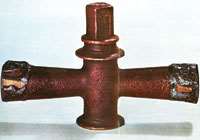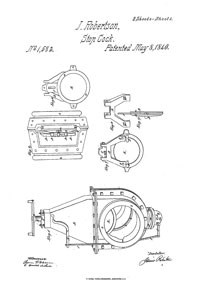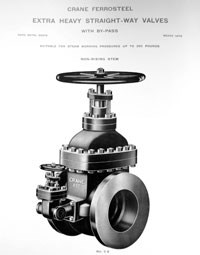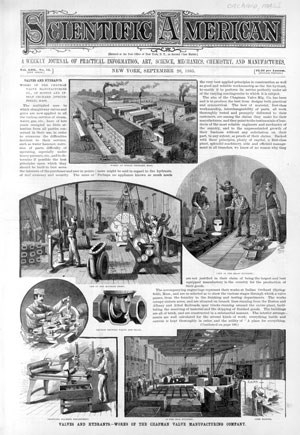From a Humble Beginning, an Industry Rises
Although VMA members might think the valve industry began with formation of the Valve Manufacturers Association on Sept. 1, 1938, in reality, the industry in this nation was around for 100 years before that date, its roots firmly attached to the American industrial landscape.
#valvehistory #VMAnews
What’s more, while most basic valve designs were conceived during the late 19th and early 20th centuries, the first valves as we know them can be traced back over 2,000 years. Valve engineers feel like they are breaking new ground when they boot up AutoCAD and draw up a new valve design. But that design often was unveiled decades or even centuries before. Take the plug valve, for example. During the early 1900s, numerous patents came out for plug valves, most notably designs by Sven Johan Nordstrom. But examples of bronze plug valves have been unearthed in many early Roman Empire archaeological sites. These plug valves were of a bronze alloy that amazingly is nearly identical to the ASTM B67 bronze chemistry still in use today.
Like technology in general, valve engineering and design slept through the dark ages. Glimmers of valve technological advancement were brought forth by that famous artist and inventor, Leonardo DaVinci.
MATERIALS
Valve materials in the 19th century were strictly in the realm of bronze and cast iron. Although viewed today as only capable of handling pedestrian pressures and temperatures, these materials were state-of-the-art in 1890. However, the service conditions of the era were not nearly as demanding. A high-pressure boiler of the late 1880s, for example, would be running at an operating pressure of only about 200 psi. Because of this, the bronze and iron materials worked well, except when the components were exposed to dangerous overpressures.
It didn’t take industry long to push the boundaries of the standard valve materials of the day. It soon was no longer feasible to design and manufacture cast iron valves to meet higher pressures and temperatures produced by the newest steam boilers.
High capacity steel production began in the U.S. in the 1860s with the inception of the Bessemer process. This process made the production of large batches of steel economical. However, steel didn’t reach the valve industry for many years. For nearly 40 years after those first batches, the primary use of the steel was producing rails for the railroad transportation empire spreading across the continent. By the end of the century, however, new processes for steel-making had been developed that greatly increased the productivity of steel foundry work. These processes, such as the electric arc furnace, opened the door for steel usage in the valve and fitting industry—just in time to meet the needs of the newer high-pressure, high-temperature steam generation.
Valves and steel have been a natural and a long-lived marriage that exists to this day. The explosion of the steel valve industry, however, began during the first decade of the 20th century. No longer would the brittleness and 23,000 psi tensile strength of 19th century cast iron limit valve construction. Instead, the greater strength (70,000 psi tensile) and ductile qualities of cast steel opened new doors for valve design.
VALVE TYPES
While the primary industry focus was on gate, globe and check valves in the early days, control and pressure relief valves also were important. In fact, the first valve of importance to the steam power industry was the safety valve. Such valves were designed to open when dangerous pressures were achieved in the steam boilers. On the initial designs, an adjustable, weighted lever-arm was attached to the closure member (disc) of the valve. The weight was positioned on the lever-arm to match the force exerted on the closure member inside the pressure boundary. As the pressure rose, the weighted disc moved upward and relieved pressure. Later designs would incorporate an adjustable spring to balance the pressure.
Control valves were important in 19th century piping systems as well. These valves were initially called governors, pressure-reducing valves, back pressure valves or automatic relief valves. The control valve industry, like other valve industry segments, received its initial impetus from the control and regulation of steam power.
By 1900, the valve industry was very healthy and gaining maturity rapidly; however, virtually every manufacturer was doing things its own way and to its own standards and specifications. This situation created a dilemma for the equipment owner; brand X wouldn't mate up with either brand Y or brand Z. Pressure standards were virtually non-existent as well. It was clear that, if the valve industry was to take the next step in its growth cycle, standardization was needed. Stay tuned to the next column in this series for the story of U.S. valve standardization.
GREG JOHNSON is president of United Valve (www.unitedvalve.com), Houston, and is a contributing editor to Valve Magazine. He serves as chairman of VMA's Education & Training Committee, is a member of the VMA Communications Committee and is on the board of the Manufacturers Standardization Society. In 2010, Johnson was the recipient of VMA’s top honor, the “Man of the Year” award. Reach him at greg1950@unitedvalve.com.
RELATED CONTENT
-
The U.S. Valve Industry in World War II
While valves didn’t directly sink ships or shoot down planes, the American valve industry played an important role in winning World War II for the allies.
-
VMA Looks Back at 2012 and Forward to 2013
Contrary to dire predictions, the end of the Mayan calendar signaled only the end of one cycle and the beginning of another, while the end of 2012 signaled the end of another banner year for the Valve Manufacturers Association and the beginning of an exciting 2013.
-
A History Made in Metal
Today’s valve material choices are like a Chinese buffet: Everything imaginable is on the menu.











 Unloading large gate valve.jpg;maxWidth=214)


